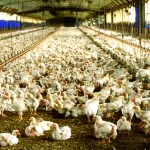 The prevalence and variation of the H9N2 chicken virus may reveal insights into the ongoing Chinese influenza A (H7N9) outbreak, according to data recently published in Proceedings of the National Academy of Sciences.
The prevalence and variation of the H9N2 chicken virus may reveal insights into the ongoing Chinese influenza A (H7N9) outbreak, according to data recently published in Proceedings of the National Academy of Sciences.
Researchers tracked the H9N2 chicken virus from 1994 to 2013 using whole genome sequencing. They found that the efficacy of regular poultry vaccination sharply declined in 2010 and 2011 when the G57 genotype became widespread. Mutations within the new subtype allowed it to become highly adaptive, as well as more likely to swap genes with influenza viruses affecting other species.
“The emergence of this dominant H9N2 virus was the first step in the genesis of the H7N9 viruses because it greatly increased the likelihood of reassortment between H9N2 and other flu subtypes,” Jinhua Liu, PhD, of the College of Veterinary Medicine at the China Agricultural University in Beijing, said in a press release.
Researchers wrote that the different influenza viruses likely circulated within infected chickens, allowing H9N2 to swap genes with duck, quail and, eventually, human influenza viruses. The result is an H7N9 strain that shares six genes with the predominant chicken virus and is responsible for 375 cases of illness and 115 deaths as of Dec. 29, the release said.
“Sequencing the viral genome allowed us to track how H9N2 evolved across time and geography to contribute to the H7N9 virus that emerged as a threat to human health in 2013,” Robert Webster, PhD, of the department of infectious diseases at St. Jude Children’s Research Hospital, said in the press release. “The insights gained from this collaboration suggest that tracking genetic diversity of H9N2 on poultry farms could provide an early warning of emerging viruses with the potential to spark a pandemic.”
Source: Healio

















